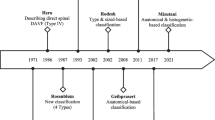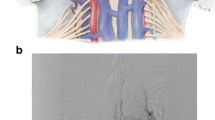Abstract
Objective
Pediatric spinal vascular diseases are extremely rare. We aimed to evaluate their clinical characteristics and treatment outcomes in our institute.
Design
A total of 10 patient files were retrospectively reviewed, including 3 cases of intramedullary arteriovenous malformations (AVMs), 6 cases of perimedullary arteriovenous fistulas (AVFs), and 1 case of epidural AVF. Clinical features, radiological findings, treatment results, and clinical outcomes were evaluated. The median durations of the radiologic and clinical follow-ups were 17.7 and 107.9 months, respectively.
Results
The male to female ratio was 1:1, with a median age at diagnosis of 9 years. All AVMs were juvenile type, all perimedullary AVFs were high flow types (three type IVb and three type IVc), and one epidural AVF was associated with intradural venous drainage. Most cases (90 %) were located in the cervical spine and conus medullaris. Acute neurological deterioration was identified in five patients; however, bleeding was identified in only one patient. Two cases were surgically treated, seven cases underwent embolization, and one case underwent radiosurgery. Three cases were completely obliterated, and their clinical states were improved (n = 2; 66.7 %) and stationary (n = 1; 33.3 %). Meanwhile, seven cases were incompletely obliterated, and their clinical states were improved (n = 2; 28.6 %), stationary (n = 3; 42.8 %), and aggravated (n = 2; 28.6 %).
Conclusions
Pediatric spinal AVMs and AVFs were mostly complex and high flow types, and complete obliteration could not be satisfactorily achieved. Incompletely treated lesions should be closely followed up because they may worsen.



Similar content being viewed by others
References
Kiyosue H, Tanoue S, Okahara M, Hori Y, Kashiwagi J, Mori H (2013) Spinal ventral epidural arteriovenous fistulas of the lumbar spine: angioarchitecture and endovascular treatment. Neuroradiology 55:327–336
Cho WS, Kim KJ, Kwon OK, Kim CH, Kim J, Han MH, et al. (2013) Clinical features and treatment outcomes of the spinal arteriovenous fistulas and malformation: clinical article. J Neurosurg Spine 19:207–216
Kalani MY, Ahmed AS, Martirosyan NL, Cronk K, Moon K, Albuquerque FC, et al. (2012) Surgical and endovascular treatment of pediatric spinal arteriovenous malformations. World Neurosurg 78:348–354
Rodesch G, Hurth M, Alvarez H, Ducot B, Tadie M, Lasjaunias P (2004) Angio-architecture of spinal cord arteriovenous shunts at presentation. Clinical correlations in adults and children. The Bicêtre experience on 155 consecutive patients seen between 1981-1999. Acta Neurochir (Wien) 146:217–226
Spetzler RF, Detwiler PW, Riina HA, Porter RW (2002) Modified classification of spinal cord vascular lesions. J Neurosurg 96:145–156
Cullen S, Alvarez H, Rodesch G, Lasjaunias P (2006) Spinal arteriovenous shunts presenting before 2 years of age: analysis of 13 cases. Childs Nerv Syst 22:1103–1110
Du J, Ling F, Chen M, Zhang H (2009) Clinical characteristic of spinal vascular malformation in pediatric patients. Childs Nerv Syst 25:473–478
Meng X, Zhang H, Wang Y, Ye M, He C, Du J, et al. (2010) Perimedullary arteriovenous fistulas in pediatric patients: clinical, angiographical, and therapeutic experiences in a series of 19 cases. Childs Nerv Syst 26:889–896
Park TS, Cail WS, Delashaw JB, Kattwinkel J (1986) Spinal cord arteriovenous malformation in a neonate. Case report. J Neurosurg 64:322–324
Rodesch G, Pongpech S, Alvarez H, Zerah M, Hurth M, Sebire G, et al. (1995) Spinal cord arteriovenous malformations in a pediatric population children below 15 years of age the place of endovascular management. Interv Neuroradiol 1:29–42
Sure U, Wakat JP, Gatscher S, Becker R, Bien S, Bertalanffy H (2000) Spinal type IV arteriovenous malformations (perimedullary fistulas) in children. Childs Nerv Syst 16:508–515
McCormick PC, Torres R, Post KD, Stein BM (1990) Intramedullary ependymoma of the spinal cord. J Neurosurg 72:523–532
Aminoff MJ, Logue V (1974) The prognosis of patients with spinal vascular malformations. Brain 97:211–218
Antonietti L, Sheth SA, Halbach VV, Higashida RT, Dowd CF, Lawton MT, et al. (2010) Long-term outcome in the repair of spinal cord perimedullary arteriovenous fistulas. Am J Neuroradiol 31:1824–1830
Lee YJ, Terbrugge KG, Saliou G, Krings T (2014) Clinical features and outcomes of spinal cord arteriovenous malformations: comparison between nidus and fistulous types. Stroke 45:2606–2612
Krings T, Chng SM, Ozanne A, Alvarez H, Rodesch G, Lasjaunias PL (2005) Hereditary hemorrhagic telangiectasia in children: endovascular treatment of neurovascular malformations: results in 31 patients. Neuroradiology 47:946–954
Poisson A, Vasdev A, Brunelle F, Plauchu H, Dupuis-Girod S, French Italian HHT network (2009) Acute paraplegia due to spinal arteriovenous fistula in two patients with hereditary hemorrhagic telangiectasia. Eur J Pediatr 168:135–139
Niimi Y, Matsukawa H, Uchiyama N, Berenstein A (2015) The preventive effect of endovascular treatment for recurrent hemorrhage in patients with spinal cord arteriovenous malformations. Am J Neuroradiol 36:1763–1768
Ashour R, Orbach DB (2015) Lower vertebral-epidural spinal arteriovenous fistulas: a unique subtype of vertebrovertebral arteriovenous fistula, treatable with coil and Penumbra Occlusion Device embolization. J Neurointerv Surg. doi:10.1136/neurintsurg-2015-011677
Chuang NA, Shroff MM, Willinsky RA, Drake JM, Dirks PB, Armstrong DC (2003) Slow-flow spinal epidural AVF with venous ectasias: two pediatric case reports. Am J Neuroradiol 24:1901–1905
Shovlin CL, Guttmacher AE, Buscarini E, Faughnan ME, Hyland RH, Westermann CJ, et al. (2000) Diagnostic criteria for hereditary hemorrhagic telangiectasia (Rendu-Osler-Weber syndrome). Am J Med Genet 91:66–67
Silva N Jr, Januel AC, Tall P, Cognard C (2007) Spinal epidural arteriovenous fistulas associated with progressive myelopathy. Report of four Cases J Neurosurg Spine 6:552–558
Srivatanakul K, Songsaeng D, Ozanne A, Toulgoat F, Lasjaunias P (2009) Spinal arteriovenous malformation associated with syringomyelia. J Neurosurg Spine 10:436–442
Acknowledgments
This research was supported by a grant from the Korea Health Technology R&D Project through the Korea Health Industry Development Institute (KHIDI), funded by the Ministry of Health & Welfare, Republic of Korea (grant number: HI12C0066).
Author information
Authors and Affiliations
Corresponding author
Ethics declarations
This study was approved by the Seoul National University Hospital Institutional Review Board.
Conflict of interest
The authors have no conflict of interest to disclose.
Rights and permissions
About this article
Cite this article
Cho, WS., Wang, KC., Phi, J.H. et al. Pediatric spinal arteriovenous malformations and fistulas: a single institute’s experience. Childs Nerv Syst 32, 811–818 (2016). https://doi.org/10.1007/s00381-016-3035-0
Received:
Accepted:
Published:
Issue Date:
DOI: https://doi.org/10.1007/s00381-016-3035-0




